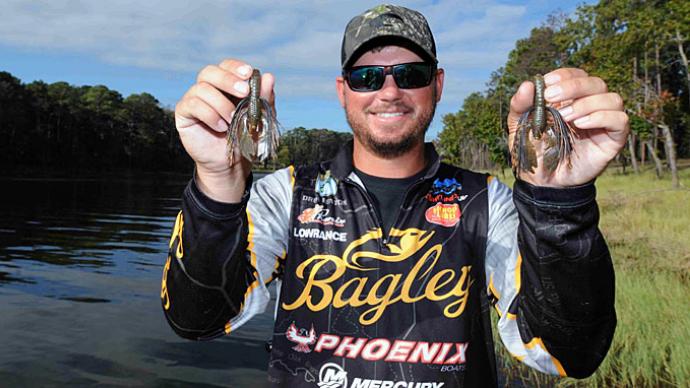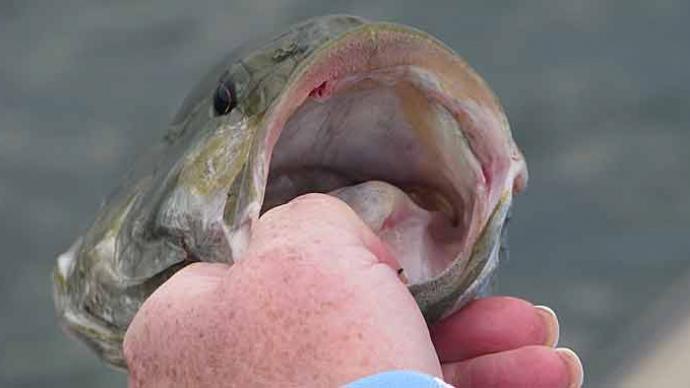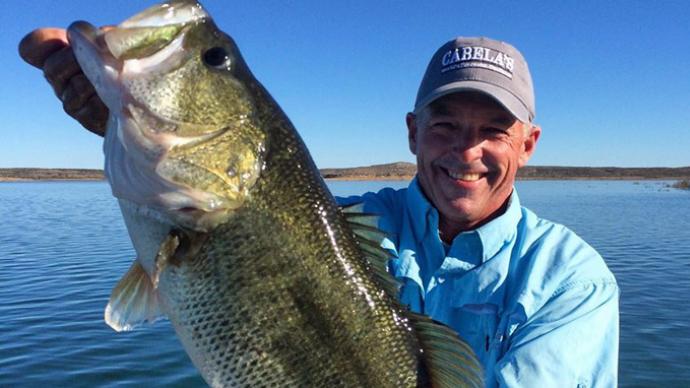
Up shallow fish are easy to see, and fish on beds are even easier to see. When the water gets to be between 55 and 65 degrees, the smaller male bass will start heading toward shallow areas with hard or gravel bottoms. They use their tails to sweep out a circle, which looks like a big white plate on the bottom. Later, the bigger females will come up, choose a nest (or nests), and lay thousands of eggs the male will fertilize. Right after laying her eggs, the female will leave, but the male will stay to guard the eggs until the fry can make it on their own.
Sight fishing most often involves taking a spawning bass off the bed. Some people are dead set against this, arguing that a big female should be left alone to get her good genes into the pool. However, a big female has probably spawned many times before, so her genes are already in the pool. Even if every angler in a large tournament took a limit of bass off the beds, it wouldn’t have much effect on the population. In 2008, the journal “Transactions of the American Fisheries Society” published a study showing that closing areas for the spawn rarely has any effect on the bass population – not only because of the prevalence of catch and release fishing, but also because even if you lose some nests, the ones that are left have a better chance of survival.
If you take a male off the nest and leave the eggs or fry unguarded, predators will quickly move in and decimate the nest. Any spawn that survives will have less competition for hiding places and food. Although there is no scientific evidence that bed fishing hurts a fishery overall, many people, including fishermen, still hate the idea of taking fish off the nest. Some are against it during tournaments because the amateur is stuck in the back of the boat twiddling his thumbs, sometimes for a very long time, while the pro tries to tease the bedding fish into biting.
I once fished with a guy who told me that he was once a non-boater in a spring tournament, and his pro partner made him lie down in the boat while the pro was fishing a bed – so the fish wouldn’t see him. That is beyond what any pro should be allowed to do – an extreme case. But it sometimes seems like you may as well take a nap if your pro has his heart set on bed fishing. That isn’t the case, though – all through the spring, fish will be in various stages of the spawn, and if you’re in a good spawning cove, there are several techniques you can use that will help you put some fish of your own in the boat. More about that later.
From The Front Of The Boat
We went out sight fishing with Lawrence Dwonch, an Arizona tournament angler who has spent quite a bit of time perfecting his bed fishing technique. The water temperature was 67.5, there had been a full moon the night before, and there were boats everywhere – fishing for a big Wild West Bass Tournament the next day. As we idled toward the back of a big bay, Dwonch was hoping that the fish he had seen a few days before were still there. “If I’m pre-fishing for a tournament, I don’t even throw a lure at the bed fish,” he said. “I just mark them on my GPS and try to find a bunch more.” Most of the anglers we saw seemed to concentrate on the banks that looked a bit lusher – the water is unusually high this year, and there are a lot of trees in the water at Lake Pleasant.
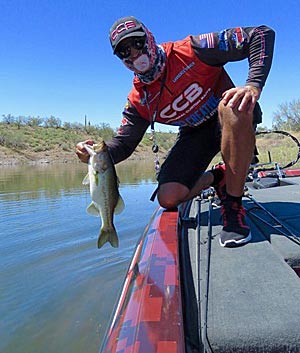
Lawrence, however, headed to a nothing-looking bank and immediately spotted the nest he had marked. There were two fish on it, circling and keeping close by. Good polarized sunglasses are a must to see into the water. Even with those, it can sometimes be challenging to spot the bass if the water is stained, but the nest is usually easier to see. He positioned the boat so his shadow wouldn’t fall on the nest and threw out a dark green Texas-rigged craw. He moved it slowly, dragging it into the nest, then shook it a bit and stopped. “The bass are still rubbing,” he said, “and that can make it harder to get them to bite.” Rubbing is what the bass do when they are actively laying eggs. The female rolls and rubs on the nest, and the male rubs her sides to loosen the eggs. At this point, they aren’t much interested in eating, but the males will sometimes defend the nest.
Dwonch reeled in, dipped the craw in some chartreuse dye, and threw it back out. He rigs it on a 3/8-ounce tungsten weight so he can cast accurately and get it in position quickly. In minutes, he had a fish in the boat. “I use Liquid Mayhem gel and just pop the lure up and down in the middle of the nest,” he said. “There’s lots of action in those claws, and the chartreuse is a bluegill color. It makes them mad, and they grab it.” It was back on the nest five minutes after he let the fish go. In clear water, he uses more natural colors; in dark water, he uses chartreuse or white. It’s essential that you can see the bait because sometimes the only way you know it’s been picked up is if you can’t see it anymore. The bass will pick it up to move it, and you’ve got to set the hook quickly.
As he cruises the shallows looking for beds, Dwonch fires a wacky-rigged Senko into the little cuts that are too shallow to get the boat into. Another technique he likes is to throw a Chatterbait out, swim it a bit, and drop it on the bed. He says the males nail that thing, and you can do that even if you can’t see the beds. It just takes some time. He also likes to use a Ned rig with a 3.5” Z-Man Trick Shotz bait (in White Lightning) about 18 inches up the line. The Trick Shotz are super buoyant and flexible. With the Ned rig in the bed and the minnow above, he shakes the line, and they’ll often hit the minnow.
Boat control is crucial when bed fishing and those Power Poles at the back of the pro’s boat come in handy. If you don’t have those, you may have to get the boat up against the shore and use the trolling motor to keep it in position. An automatic trolling motor that can keep you in one spot is beneficial, but you don’t have to have that stuff – just an ability to control your boat or a way to make it stay put. I’ve seen guys tie up to trees and drop anchors – whatever it takes to keep that boat long enough to entice that bass.
Dwonch keeps four rods on deck: a Texas-rigged craw, a Senko for a slow sink, the Ned rig, drop-shot combo, and a small hinged bluegill swimbait. A lot of these fish have seen a ton of plastics, he says, so if he can’t get them to go on a soft plastic, he throws a little bluegill swimbait in there. Bluegills are their arch enemies this time of year, and the male will attack one if he’s guarding eggs or fry.
In A Tournament
Bed fishing can be a tricky thing to depend on for a tournament. If everything is perfect, you can come to the scales a hero, but if the weather acts up, it can be a disaster. For the Wild West, the day after we were out, there were killer winds that made it pretty much impossible to see any beds, which ruined the day for many anglers, I’m sure. Another thing that can mess you up in a tournament is the other competitors. Lawrence once marked (on GPS) a lot of beds for one competition, but on tournament day, he drew a high number and found 3 to 5 boats in every cove he had marked. Those fish, he said, either got picked or spooked. You should always have a backup plan.
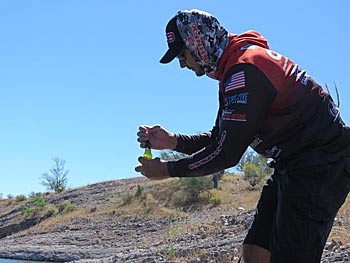
If you’re the non-boater, fishing behind a bed fisherman can make you want to pull your hair out. You’re just stuck there until he sticks the fish or gives up trying, which can take a long time. However, those fish on that bed are not the only fish in the lake or the cove. If the pro asks you not to fish shallow, you should probably respect his wishes. He pays a lot more to get in, and it’s his boat. But you can tie on a Carolina rig, a split shot rig, or even a dropshot and fish the channels and drop-offs. You can learn a lot by watching him, too.
My favorite thing to use is a Carolina rig. You can use a heavy weight, even with small bait, and cast that rig a mile. Throw it out in the middle and drag it up the channel. Use the rod to move the rig, pulling it to the side, then reel up the slack as you move the rod back into position. When you start pulling again, set the hook if it feels heavy. I’ve caught some massive fish on Carolina rigs, even from the back of the boat. If your pro doesn’t mind you fishing shallow, throw out a drop shot or a split-shot rig and sort of hop-drag it down the bank at an angle. I usually toss it out, let the line settle, reel up the slack, and lift the rod a bit to pick the bait up. Let it fall again and watch for the line to slack so you know it is on the bottom, then reel up the slack again. If, when you pick it up, it feels heavy or like you’ve snagged a rubber band, set the hook. Sometimes the fish will take it as they cruise, so watch the line for any sideways movement. Ditto if it never hits bottom – most likely because a fish picked it up. If there is a point nearby, see if you can reach the side of it with your lure. That’s prime post-spawn territory.
Bottom Line
Unless tournament circuits or fisheries departments forbid bed fishing, anglers will be taking fish off the nests. Some anglers worry that taking fish off beds gives the non-fishing public a bad image of bass fishermen, but it boils down to this: if you don’t like the idea of bed fishing, then don’t do it. The subject can be polarizing (what can’t these days?), but as bass fishermen, we need to stand together, supporting each other’s right to fish – as long as no laws are broken.


